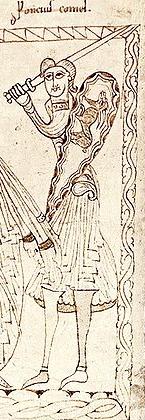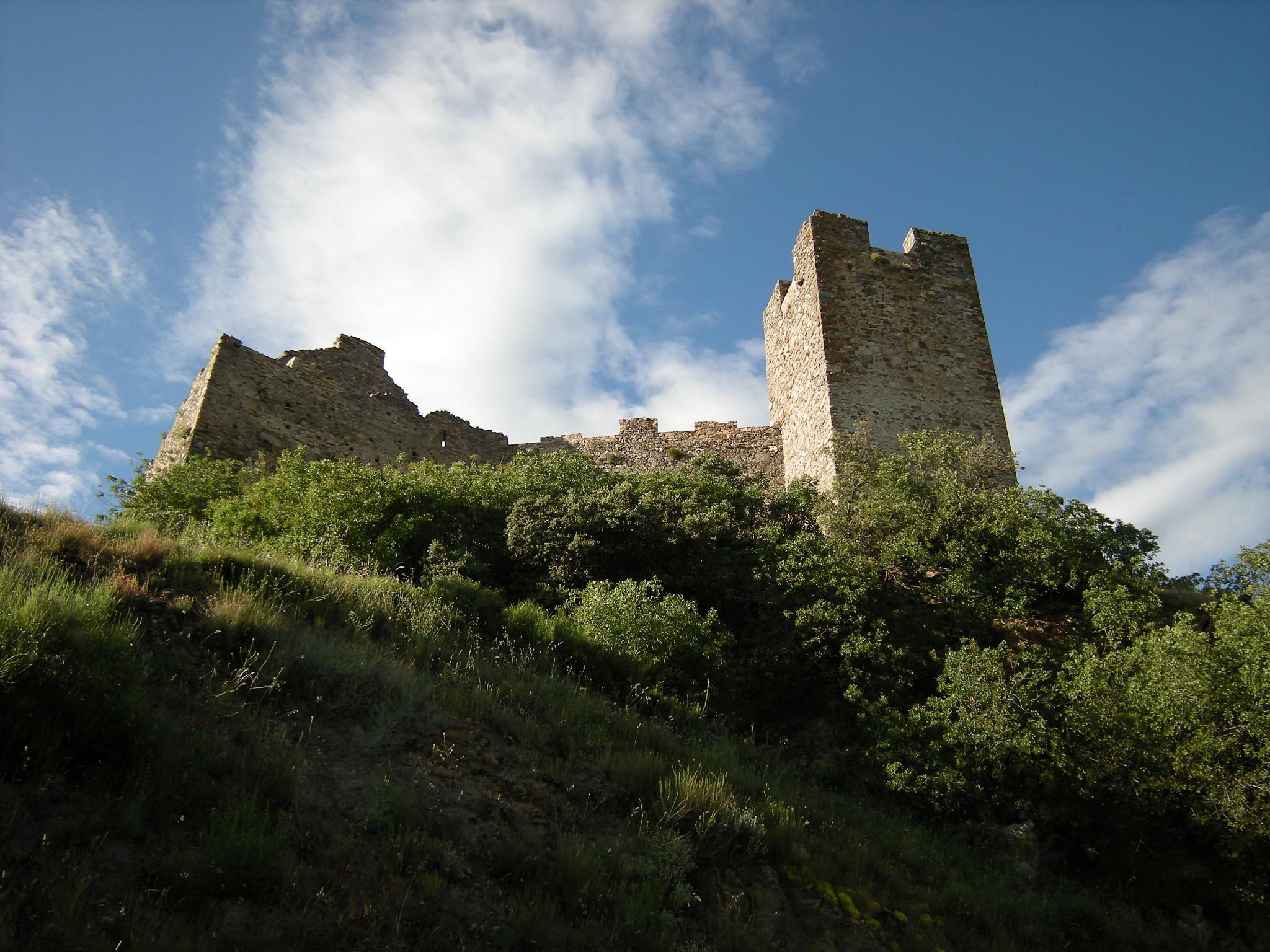|
Ponce Giraldo De Cabrera
Ponce Giraldo de Cabrera (''floruit'' 1105–1162), called Ponç Guerau (or Grau) in Catalan or Pons in Occitan, was a Catalan nobleman, courtier and military leader in the kingdoms of León and Castile. Ponce came to León in the entourage of Berenguela, daughter of Ramon Berenguer III, Count of Barcelona, when she married King Alfonso VII of León at Saldaña in November 1127.Simon Barton, ''The Aristocracy in León and Castile'' (Cambridge: 1997), 284–85. Immediately after his arrival, Ponce assumed a position of some importance in the kingdom. By 1143 he held the title of count (Latin ''comes''), the highest rank of the Leonese nobility. By 1145 he had been appointed the king's majordomo, the highest official in the realm.Bernard F. Reilly, ''The Kingdom of León-Castilla under King Alfonso VII, 1126–1157'' (Philadelphia: University of Pennsylvania Press, 1998), 163. Early career (1126–1140) Catalan origins Ponce was a son of Guerau II de Cabrera, the first viscou ... [...More Info...] [...Related Items...] OR: [Wikipedia] [Google] [Baidu] |
Pedro Ansúrez
Pedro Ansúrez (''floruit'' 1065–1117; died probably 9 September 1118) was a Kingdom of Castile, Castilian nobleman, count of Liébana, Saldaña, Palencia, Saldaña and Carrión de los Condes, Carrión in the closing decades of the eleventh century and the opening decades of the twelfth. He is considered the founder and first lord of Valladolid. Pedro was a descendant of the Beni Gómez family of Castilian nobility, the son of Ansur Díaz, by his first wife, whose name is unknown. His grandfather, Diego Fernández (count of Saldaña), Diego Fernández, was a count of Saldaña and Carrión. Pedro married twice, the first time by 17 June 1084Barton, ''Aristocracy'', 275–76. to Elo (or Eylo), daughter of Count Alfonso Muñoz and Aldonza González of Trigueros del Valle, Trigueros. She was dead by 17 September 1114, when Pedro made a donation for the good of her soul to the canons of the cathedral of Valladolid, and he appears the next day with his second wife, Elvira Sánchez, w ... [...More Info...] [...Related Items...] OR: [Wikipedia] [Google] [Baidu] |
Ramiro Fróilaz
Ramiro Fróilaz (''floruit'' 1120–1169) was a Leonese magnate, statesman, and military leader. He was a dominant figure in the kingdom during the reigns of Alfonso VII and Ferdinand II. He was primarily a territorial governor, but also a court figure, connected to royalty both by blood and by marriage. The military exploits of his sovereigns involved him against both the neighbouring kingdoms of Navarre and Portugal and in the ''Reconquista'' of the lands of al-Andalus. Family Ramiro was the eldest son of Fruela Díaz and Estefanía Sánchez of the Navarrese royal house, daughter of Sancho Garcés, Lord of Uncastillo. Ramiro's first wife was Inés (Agnès), perhaps a member of the French royal house or the family of the Counts of Armagnac. She was buried in the church of San Isidoro de León, where her epitaph names her husband and describes her as "descended from the kings of France". She was the mother of his eldest two sons, Alfonso and Fruela. On 22 September 1150 Ramir ... [...More Info...] [...Related Items...] OR: [Wikipedia] [Google] [Baidu] |
Bierzo
El Bierzo (; ; gl, O Bierzo) is a ''comarca'' in the province of León, Spain. Its capital is the town of Ponferrada. Other major towns are Bembibre and Villafranca del Bierzo, the historical capital. The territory of El Bierzo includes most of the upper basin of the Sil river. It is surrounded by mountains on all sides, which makes this area remarkably isolated from all neighbouring lands. History In pre-Roman times the region was populated by the Astures, a Hispano-Celtic Gallaecian people. They were conquered by Emperor Augustus in the Astur-Cantabrian Wars (29–19 BC) and the area quickly became the largest mining center of the Empire during the Roman period, where gold and other metals and minerals were extracted. Numerous Roman mining sites are still visible in the area, one of the most spectacular being Las Médulas, a UNESCO World Heritage Site since 1997. Romans also imported grapevines, and wine production thrived in the region until the propagation o ... [...More Info...] [...Related Items...] OR: [Wikipedia] [Google] [Baidu] |
Merindad
''Merindad'' () is a Mediaeval Spanish administrative term for a country subdivision smaller than a province but larger than a municipality. The officer in charge of a merindad was called a merino, roughly equivalent to the English ''count'' or ''bailiff''. It was used in the kingdoms of Castile and Navarre. Connected to the birth of Castile, the Merindades, standing for a northernmost ''comarca'' of the province of Burgos, was part of the creation of the administrative division by King Peter. Currently, the Foral Community of Navarre is still divided into five ''merindades'' standing for different judicial districts. The historic ''Merindad de Ultrapuertos'' lying to the north of the Pyrenees is nowadays Lower Navarre. Administratively, they have been substituted by the '' partido judicial''. In Biscay, the ''mancomunidades comarcales'' keep the place of the old ''merindades'', such as Duranguesado. See also * Partidos of Buenos Aires, a second-level administrative subdiv ... [...More Info...] [...Related Items...] OR: [Wikipedia] [Google] [Baidu] |
Castillo De Cornatel
Priaranza del Bierzo (Priaranza in Galician language) is a village and municipality located in the region of El Bierzo (León (province), province of León, Castile and León, Spain) . According to the 2006 census (Instituto Nacional de Estadística (Spain), INE), the municipality has a population of 918 inhabitants. It is one of Galician language, Galician speaking councils of El Bierzo Towns * Priaranza del Bierzo / Priaranza * Villalibre de la Jurisdicción * Santalla del Bierzo / Santalla * Paradela de Muces * Villavieja / A Vilavella * Cornatel / Cornatelo Cornatel Castle (''Ulver'') File:Castillo_de_Cornatel.JPG, The Cornatel Castle in Priaranza del Bierzo, built in the 9th century. File:Cornatel_01.JPG, Cornatel Castle as seen from the Hanging House. File:Castillo_de_Cornatel.jpg, View of the southern side. File:Castillo de Cornatel de Noche.jpg, View of the Cornatel Castle at night. References Municipalities in El Bierzo {{León-geo-stub ... [...More Info...] [...Related Items...] OR: [Wikipedia] [Google] [Baidu] |
Cartulary
A cartulary or chartulary (; Latin: ''cartularium'' or ''chartularium''), also called ''pancarta'' or ''codex diplomaticus'', is a medieval manuscript volume or roll (''rotulus'') containing transcriptions of original documents relating to the foundation, privileges, and legal rights of ecclesiastical establishments, municipal corporations, industrial associations, institutions of learning, or families. The term is sometimes also applied to collections of original documents bound in one volume or attached to one another so as to form a roll, as well as to custodians of such collections. Definitions Michael Clanchy defines a cartulary as "a collection of title deeds copied into a register for greater security". A cartulary may take the form of a book or a ''codex''. Documents, chronicles or other kinds of handwritten texts were compiled, transcribed or copied into the cartulary. In the introduction to the book ''Les Cartulaires'', it is argued that in the contemporary diplomatic ... [...More Info...] [...Related Items...] OR: [Wikipedia] [Google] [Baidu] |
Berenguer Dalmau
Berengar is a masculine name derived from Germanic roots meaning "bear" and "spear". The name appears frequently among certain noble families during the Middle Ages, especially the Unruochings and those related. Bérenger is the French form, while Berengario is the Italian form, Berenguer is the Catalan form, and Berenguier or Berengier is the Occitan form. The Latin form is ''Berengarius'' and the female equivalent is '' Berengaria''. Other forms of the name include Berenger, Bérenger, Bérangier, or Beringer. Personal name *Berengar of Toulouse, Frankish nobleman (fl. ninth century) *Berengar I of Neustria, Frankish nobleman (fl. ninth century) *Berengar II of Neustria, Frankish nobleman (d. 896) *Berengar I of Italy, King of Italy (c. 845–924) *Berengar II of Italy, King of Italy (c. 900–966) *Judicael Berengar, Breton nobleman (fl. tenth century) *Berengar of Tours, theologian (c. 999–1088) *Berengar, Bishop of Venosa (fl. eleventh century) *Henry Berengar, junior co-Ki ... [...More Info...] [...Related Items...] OR: [Wikipedia] [Google] [Baidu] |
Bishop Of Girona
The Roman Catholic Diocese of Girona ( la, Gerunden(sis)) is a diocese located in the city of Girona in the Ecclesiastical province of Tarragona in Catalonia, Spain."Diocese of Girona" ''''. David M. Cheney. Retrieved February 29, 2016"Diocese of Girona" ''GCatholic.org''. Gabriel Chow. Retrieved February 29, 2016 History The first historical mention of a Christian diocese in Girona is in a paper for |
Guillem Ramon II De Montcada
Guillem () is a Catalan first name, equivalent to William in the English language, which occasionally can appear as a surname. Its origin and pronunciation are the same as its Occitan variant ''Guilhèm'', with a different spelling. People with the first name Guillem * Guillem I de Cerdanya ((1068–1095); anglicised William I of Cerdanya), Count of Cerdanya and Berga *Guillem Ademar (fl. 1190/1195–1217), troubadour *Guillem Agel i Barrière (1753-1832), publisher and printer from Roussillon *Guillem Agulló i Salvador (1975–1993), murdered Valencian member of Maulets *Guillem Augier Novella, 13th century French troubadour *Guillem Balagué, sports journalist *Guillem Bauzà (1984-), Majorcan football player *Guillem Bofill, Catalan architect of the Girona Cathedral *Guillem Colom Ferrà (1890–1979), Majorcan translator and poet *Guillem d'Areny-Plandolit (1822–1876), Andorran politician who led the New Reform *Guillem de Balaun (fl. bef. 1223), Castellan of Balazuc and tr ... [...More Info...] [...Related Items...] OR: [Wikipedia] [Google] [Baidu] |
Viscounty Of Bas
The Viscounty of Besalú, or Bas (from the Latin ''Basso''), was the sub-comital authority in the county of Besalú during the Middle Ages. It was ruled by the House of Cervera (also called ''Cerveró(n)'' or ''Cervelló(n)'', from the Latin ''Cervaria''). * Bernard I, circa 986 *Huguet, circa 1000 * Udalard I, 1079–1115 * Udalard II, 1115–1123 *Peter I, 1123–1127 *Beatrice, 1127–1142 ** Ponce I Hugh, 1127–1130, husband * Peter II, c. 1130–1140 (associat 1130–1140) * Ponce II, 1140–1155 (associat 1140–1142) * Hugh I, 1155–1185 * Ponce III, regent 1185–1195 *Peter III, regent 1195–1198 * Hugh II, 1198 (nominally 1185–1221) * Hugh III, regent 1198–1220 * Peter IV, 1221–1241 ** Eldiarda, regent 1220–1231 *Simon, 1231–1247 (until 1241 as regent) * Sibylla, 1247–1280 * Hugh IV, 1262–1277, husband *Peter V, 1280–1285, also King of Aragon * Ponce IV, 128 ... [...More Info...] [...Related Items...] OR: [Wikipedia] [Google] [Baidu] |



